What Is French Press Coffee?
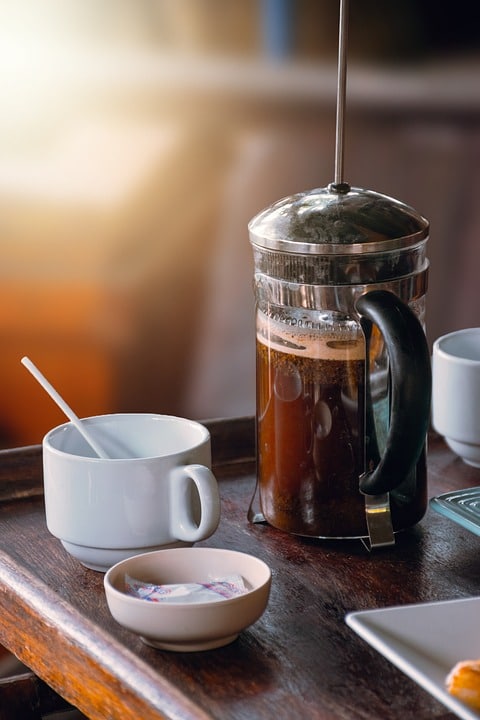
One of the easiest manual methods for brewing a nice cup of coffee is to use a French Press, or as it’s also known, a Press Pot.
A French Press is portable, non-electric and takes a few minutes to make cup or few. All you need is to add your coffee ground, add hot water, wait a few minutes for the coffee to brew, press down the filter and start enjoying your coffee!
French Press pots are available in many sizes, starting from a single-cup press to a 12-cup capacity. So whether you want to enjoy a cup for yourself, or use it to serve friends and family, you’ve got many options to choose from.
One of the great benefits of using a french press as your method of brewing is that it is relatively cheaper than other brewing methods:
- The pot itself can be quite affordable, as low $16 or so. But can also go as high as $100 and more. It all depends on the brand, material and size of the press pot you choose. So you have a lot of options to choose from.
- It’s non electrical, so no energy costs.
- A press pot is also easy to pack and keep clean. The only messy thing about a press pot is having to discard the coffee ground in a bin, since dumping them in the drain can eventually clog it up.
In this post, I’ll be talking about every aspect to help you decide whether using a french press is the right method for you or if you should go for something else. I’ll also compare french press to other brewing methods like a moka pot, pour over or a percolator.
How To Choose The Best French Press For You:
There are a few things to consider in order to pick the right french press:
Which Size Do Need?
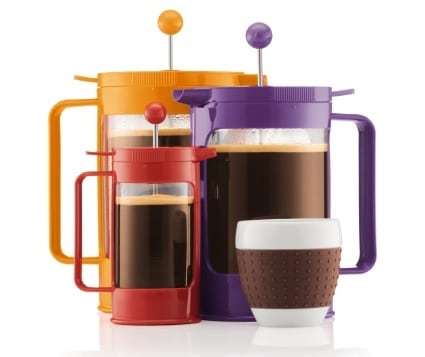
French press pots are available in many sizes, a one-cup, 4-cup, 8-cup and 12-cup capacity. But you have to keep in mind here what a ‘cup’ really is. As some, if not most brands use the term cup to refer to 5 oz capacity. So if you’re using a large 12 oz mug, or a 14 oz travel mug, then you can’t go for anything less than a 3-cup capacity. Or better yet, make sure to choose your french press based on ounce capacity and not the labeled cup size.
Which Material Do You Prefer? Glass or Stainless Steel?

There are two materials to choose from: glass or stainless steel.
- Glass press pots are the most common and they come in different styles. Some glass pots are complemented with plastic handles or exterior decoration. Others have stainless steel accents, and these are often more stylish.
- The other kind of press pot is a double-walled or vacuum insulated stainless steel press pots. This material is often more expensive, however, it is preferred for someone who wants to keep their coffee hot for a longer time.
Choosing between these two materials comes down to one thing:
How long do you want to retain the temperature of your coffee for?
- If you’re the kind of person who likes to enjoy their coffee one cup at a time, or let it sit for longer than ten or fifteen minutes, then you’ll definitely want a stainless steel press pot.
- If loss of temperature isn’t an issue for you, then you can choose the material that appeals more to you aesthetically or that’s more in line with your budget.
Best French Press Pots For Home Or Office:
Best Glass French Press Pot:
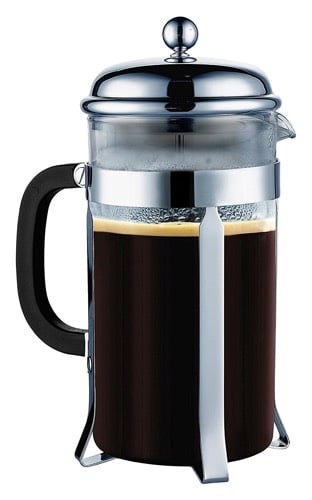
The SterlingPro Glass French Press is made of durable borosilicate glass. Available in different capacities, this press pot features:
- Metal exterior accents and lid,
- Double screen filtration
- Includes 2 extra filter replacements
The double filtration system solves an issue that some french press pots have, which is that the screen isn’t always able to filter out coffee grounds. With double-filtration, the SterlingPro is able to provide you with a clean cup of coffee.
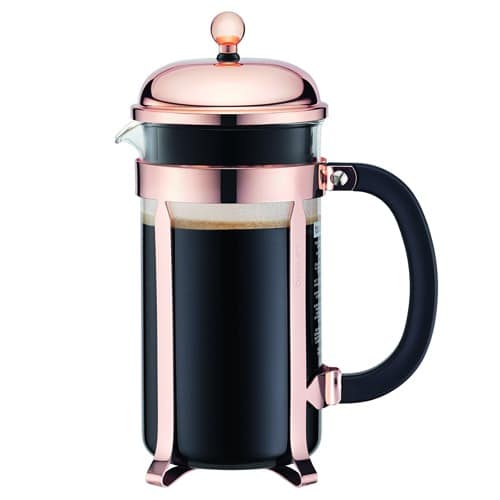
The Bodum Chambord is quite the classic. Bodum is a well known brand when it comes to french press pots, and Chambord model is by far their most elegant one. The pot is adorned with copper colored stainless steel exterior parts as well as lid. This premium design has been, and still is, crafted in Portugal for over 30 years. Other matching accessories are available such as cups, creamer and sugar set, and storage jars.
Best Double Walled Stainless Steel French Press Pots:
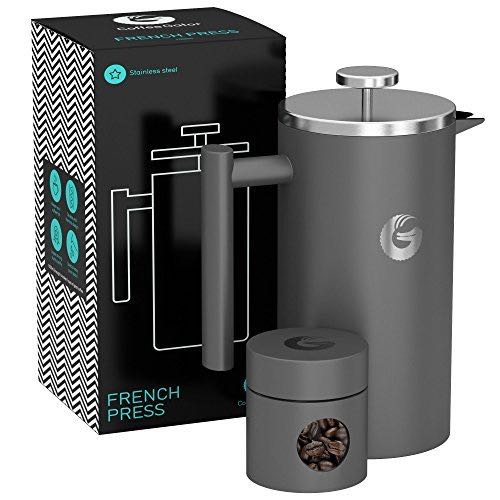
CoffeeGator’s vacuum insulated stainless steel french press makes the best value for your money. This highly rated press pot keeps your coffee hot for a long time, thanks to its double-walled stainless steel construction. It keeps your coffee hot for at least 60 minutes over glass press pots, and it remains cool to touch from the outside. It is available in four colors, and it includes a mini storage jar.
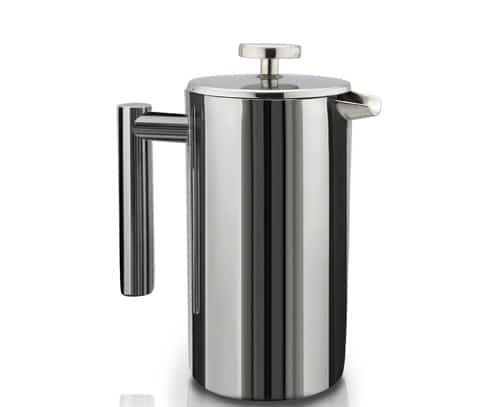
This SterlingPro double-walled french press is another great and highly rated option for a stainless steel press pot. It has more of a classic look than the CoffeeGator with polished stainless steel exterior. Like their glass pot, this too has double filtration and includes two additional replacement screens.
What Is The Best Way To Make French Press Coffee?
As you know by know, French press is the easiest way to make coffee. Most of the time, you really can’t go wrong. But if you want to make a superior cup of coffee, there are a few things to keep in mind:
It All Starts with The Coffee Grind:
You’ve probably heard this before… a good cup of coffee starts with a good grind. If you think this is some unnecessary step that won’t make a difference, just think about this for a moment:
Why does the coffee you buy from your coffee shop taste better than what you make at home?
- Because they grind the beans right before brewing
- Because they use commercial conical burr grinders
So, How Do You Grind Coffee For French Press?
I’m not saying that you should rush a bring a commercial grinder to your home. Not at all.
However, I do recommend these two things:
- Always use fresh coffee ground. Grind your coffee right before brewing. For french press, use a coarse grind.
- Use a conical burr grinder. Never a blade grinder. Burr grinders make a consistent grind which give you the best results. Blade grinders, on the other hand, make an inconsistent grind and you have no control over the coarseness of your grind. Most of the time, it results in a bitter cup.
I understand that buying a conical burr grinder can add quite a lot to a buyer’s budget. But there are some quite affordable options to consider…
Use a Manual Burr Grinder:
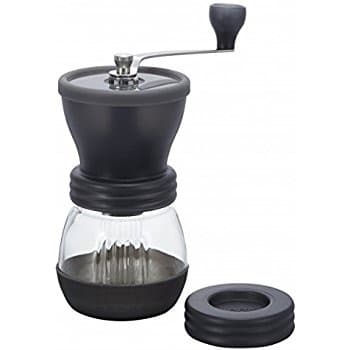
A manual burr grinder is quite an affordable as well as portable option. It can cost anywhere from $20 to $40 and more. That’s way cheaper than electric grinders that go over the price of $100.
Manual grinders have adjustable steps that allows you to adjust the coarseness of your grind. So it’s perfect to use as a grinder for french press as well as other methods (not espresso though). The downside of a manual grinder though is that it’s quite an exercise and it can get boring of a task after a while.
Don’t Want To Buy a Grinder? Here’s Your Second Option…
If you’re not entirely sold on the fact that you need to grind your coffee before brew time, or can’t afford to buy a grinder right now, your second option is to ask your local coffee house (or wherever you’re getting your coffee beans from) to grind it for you. That way you’ll still get the consistent grind of a burr grinder, but on the other hand, you’ll lose some of the freshness of the coffee. This is still a better option than using a blade grinder.
How To Brew The Coffee:
Now we got the coffee ground part covered. Here’s what else that makes a french press brew:
- Before you start, it’s always a good idea to pre heat your press and your mug. Stir some of the boiled water in the pot to make it hot, then discard before adding your coffee ground.
- Use water that is JUST off the boil. Let the water sit for a few seconds before pouring it into the pot.
- Pay attention to your water to coffee ratio. As a rule, you’ll want to use 6 oz of water for every 2 tablespoons of coffee. But you can always experiment to find out the ratio you prefer.
- Brew time: This is a crucial part of brewing the best pot of french press. Ideally, the coffee should sit to brew for exactly 4 minutes. So, start with that using a timer. If you find the taste to be not bold enough to your taste, add a minute or two to brew time.
Comparing French Press To Other Brewing Methods:
French Press vs. Percolator:
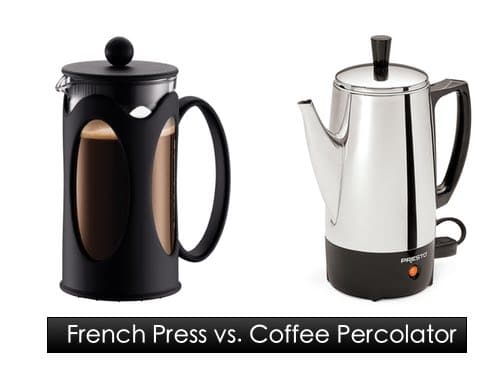
A Coffee percolator is another easy way of doing your coffee. Actually, it’s quite a classic way of doing it. It was a popular method back in the 70s, and to this day, some people still prefer it as their method of choice for brewing coffee.
Of course, coffee percolators have witnessed some improvements. Back in the day, a percolator required a stovetop to bring the water and coffee to boil. Now, both stovetop as well as electric percolators are available.
How Does a Coffee Percolator Work?
a percolator is a pot with a filter/chamber on top that holds the coffee ground. A pipe-like element in the pot works on circulating the boiling water from bottom to top and through the coffee grounds. This process continues until the desired coffee strength is achieved.
How Is It Different From French Press?
The brewing process of a percolator is entirely different than french press coffee. With a percolator, your coffee grounds are boiling with the hot water, circulating through until you take it off the stovetop or unplug it, in the case of using an electric percolator. This may result in a stronger coffee flavor, but it can also be more bitter due to the fact that the water is boiling through the coffee grounds. With a french press, the hot water (just off-boil) is mixed with the coffee ground, then it sits for a minutes until you press it down.
Pros of Using a Coffee Percolator:
- It is easier to clean. Since the coffee grounds are in a separate chamber, you simple detach that chamber and toss out the grounds.
- Whether it is a stovetop or electric, it is still fairly affordable.
- It keeps the coffee hot for a longer time, since all percolators are made of stainless steel.
Cons of Using a Percolator:
- It takes longer than a french press to brew coffee, up to 10 minutes or more.
- Most electric percolators don’t have a switch or auto-off. You have to time your brew and manually unplug them.
- It is not as portable as a french press. With a press, you simply add the hot water and let it sit. But with a percolator, you need either a direct source of heat or electricity for it to keep percolating.
French Press vs. Moka Pot:
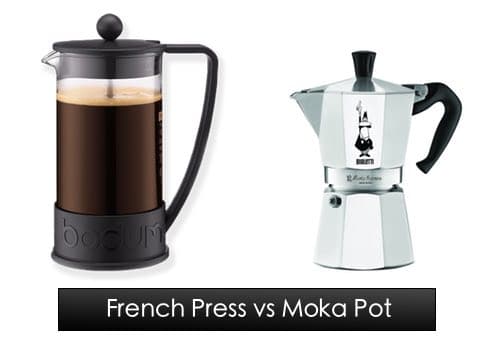
A Moka pot isn’t far off from a coffee percolator, but they make different types of coffee. With a moka pot, there are two chambers, at the bottom chamber, you’ll add your water, then on the top chamber goes your coffee ground. Once the water is boiled, it starts to move to the top chamber to immerse the coffee grounds. And when the top chamber fills up with coffee, that’s when you take it off the stovetop.
A moka pot creates a rather strong cup of coffee that is more in line with espresso. And it is usually enjoyed using smaller cups. Moka pot uses fine coffee ground, just slightly more coarse than espresso’s. It is usually preferred by people who want a coffee drink almost as strong as espresso, but without the need for an espresso machine.
That said, moka pot coffee is entirely different than french press:
- It produces a very strong cup of coffee, similar to espresso.
- It requires a stovetop.
- Moka coffee is usually enjoyed in capacity of 2 oz cups.
- You have to keep an eye on your moka pot to know when it’s done and ready to drink.
If you enjoy your coffee in larger capacity, a moka pot isn’t the right option for you. But, if you fancy an espresso-like drink, it is the method to go for.
French Press vs. Pour-Over:
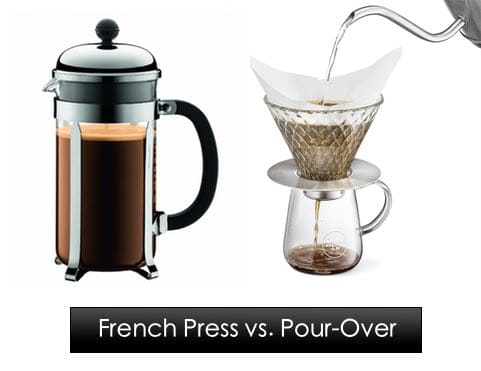
Pour-over coffee is increasingly getting popular. Manual coffee drippers like Chemex or Hario V60 are more popular than ever, even though it is not as easy of a method as french press and it requires some practice.
With pour-over, precision is the key to success. If you’ve got the right grind, measure your beans and time, you’ll get a nice cup of coffee.
Doing pour-over, you have to attend the brew process from start to end. So, unlike french press, you can’t just let it sit until it’s ready. The water has to be poured slowly over the coffee ground and little by little, until you’ve brewed your desired amount. Since pour-over drippers use paper filters, the coffee it makes is cleaner than that of a french press, since most coffee oils and all grounds get trapped in the filter.
To get the best results, it is recommended that you use a scale to measure the coffee grounds and amount of water you’re adding to your pour-over. Medium-coarse grind is used for pour-over.
So, should you choose pour-over instead of french press?
Only if you don’t mind all the work.
French press is much easier to do. It’s as simple as adding water to a pot and waiting for a few minutes. And the results are consistently good.
Pour-over can’t be done in a rush. It takes time and you have to keep at it until you get it right. It could be a fun thing to do over the weekend, but it’s not a practical method for someone who wants a quick cup of coffee. There are automatic pour-over coffee makers that automate the whole process for you, but they’re not as affordable as manual pour-overs.